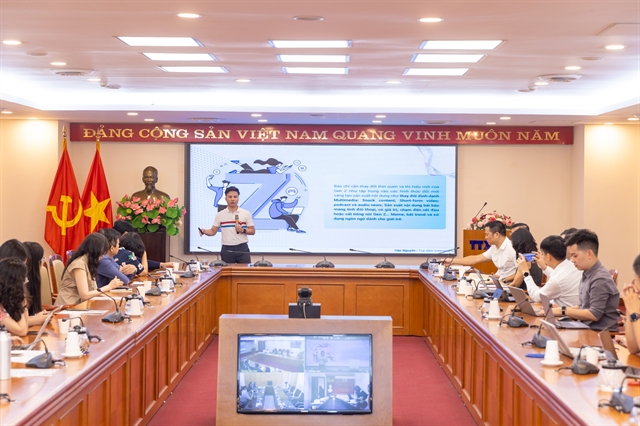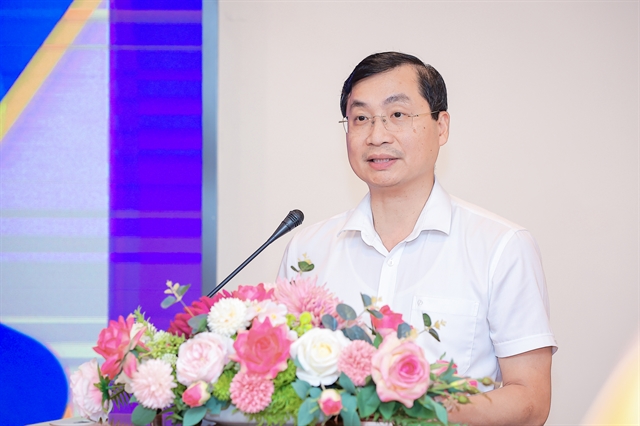 Society
Society


|
| A speaker discusses measures to attract Gen Z readers during the seminar on Tuesday. — VNA Photo |
HÀ NỘI — As social media increasingly dominates younger users' time, traditional media outlets like newspapers and television are facing a growing challenge in maintaining their influence, especially among Gen Z.
At a seminar on Tuesday titled 'Attracting Gen Z with Creative Content' held by VietnamPlus e-newspaper under Vietnam News Agency, industry professionals discussed the shifting expectations of younger readers, who are increasingly seeking immersive, multimedia-driven news experiences.
Editor-in-Chief of VietnamPlus Trần Tiến Duẩn emphasised the tech-savviness of Gen Z, a generation that grew up in the digital era.
"A survey by Statista shows that 50 per cent of Gen Z receives news daily through social media and exclusively uses mobile phones to access information," Duẩn said.
"They have developed a daily digital consumption habit when it comes to news. Gen Z is becoming one of the largest consumer groups of media today."
VietnamPlus has introduced several innovative formats to cater to the demands of this audience, including 360-degree videos, Rap News, podcasts and interactive 3D pages about historical events.
The publication also focuses on distributing official content across social media platforms, ensuring it reaches its intended audience where they spend most of their time.
Duẩn also pointed out that while the rise of new technology platforms and social media presents significant opportunities, it also brings substantial challenges.
"The emergence of new technologies and social media platforms is posing considerable challenges for media organisations in terms of operational models, competitiveness and revenue streams," Duẩn said.
"Being proactive in adopting trends, applying advanced technology and innovating content production has become crucial for survival."

|
| Trần Tiến Duẩn, Editor-in-Chief of VietnamPlus electronic newspaper, speaks at the seminar on Tuesday. — VNA Photo |
Trần Ngọc Long, Head of the Multimedia Communications Department at VietnamPlus, highlighted the differences in how Gen Z consumes news compared to previous generations: Gen Z prefers interactive, visually stimulating journalism over traditional text-based reports.
"Gen Z demands more images, interaction and elements of surprise. They enjoy engaging with content that allows them to participate in the conversation, rather than passively consume it," Long said.
Long also described the modern multimedia journalist as a 'one-man band,' responsible for writing, shooting videos, recording audio, editing and producing content across various formats.
He stressed that adapting to a multimedia newsroom model requires significant changes in mindset and organisation.
"Moving to a multimedia newsroom model requires a shift in thinking, skills, equipment and management structures," he said.
"Managers must embrace a multimedia mindset and ensure there is an appropriate financial and compensation mechanism to support multimedia content."
The seminar also discussed the success of Nhân Dân (People) Newspaper’s 2024 special supplement on the 70th anniversary of the Điện Biên Phủ Campaign (May 7, 1954)
The supplement, which attracted a large number of young readers who eagerly queued up for printed copies and shared content on social media, was hailed as a 'media miracle'.
Thi Uyên, a journalist at Nhân Dân, attributed this success to the fact that Gen Z, while quick to scroll, values thoughtful, quality content.
"Gen Z may scroll quickly, but they don’t rush through reading. They are a highly educated generation, with strong opinions and a desire for deeper, more insightful content," Uyên said.
She further explained that Gen Z tends to appreciate a different type of reading experience.
"I believe that Gen Z enjoys quality content and a distinctive reading experience. A good reading experience doesn’t necessarily need flashy effects or bright colours. It just needs to offer something fresh and meaningful," she said.
In terms of solutions for attracting young readers, Vũ Tuấn Anh, head of the Department of International Communication and Culture at the Diplomatic Academy of Vietnam, suggested that journalism must reshape its approach to the public.
Specifically, he recommended transitioning from being merely 'information deliverers' to 'community creators'. This shift would make journalism more relatable and friendly to Gen Z.
Tuấn Anh also emphasised the importance of collaboration between journalism training institutions and media organisations to provide students with opportunities to gain practical, hands-on experience.
"We aim to foster critical thinking, digital ethics and global citizenship responsibilities, with a multi-platform orientation," he said.
Nguyễn Văn Hào, from the Journalism and Communications Institute of the Academy of Journalism and Communication, argued that Gen Z’s media consumption habits are shaped by their exposure to short-form content on platforms like TikTok, YouTube Shorts and Instagram Reels.
"Gen Z prefers short videos, animated images, memes and anything that catches their eye in the first three seconds. They are used to a multimedia world, and they expect news to be presented in ways that align with that," Hào said.
Hào further explained that to engage Gen Z, journalists must avoid forcing them to read lengthy articles.
"Journalists need to understand Gen Z better, write as if having a conversation with them, create content that speaks to their experiences, and accompany them like a friend from the same generation," he said.
In his recommendations for how journalism can better connect with young readers, Hào suggested that journalists adopt a more casual and approachable tone, shifting away from overly formal or academic language.
"By translating Gen Z’s language into something more familiar, we can make content more accessible to them without sacrificing accuracy," he said. "Telling stories through images, sounds and motion, rather than just text, can make a big difference."
ONECMS Manager at NEKO Technology JSC Bùi Công Duyến offered three key solutions for media outlets hoping to engage Gen Z: Creating value: Media outlets should provide in-depth articles, exclusive interviews and solutions to issues that matter to young people. Becoming a trusted source for verifying fake news is also crucial; Follow and set trends: Media should create content that aligns with the latest trends while maintaining high entertainment value; and Use familiar language: Moving away from an academic tone, journalists should adopt natural, conversational language that resonates with Gen Z.
Duyến also recommended that media outlets tailor their content to different platforms. For example, online newspapers should focus on in-depth long-form articles, while posts to social media platforms like Facebook, TikTok and Instagram could use short-form content, such as 60-second videos or discussion posts, to engage readers quickly and effectively. — VNS




